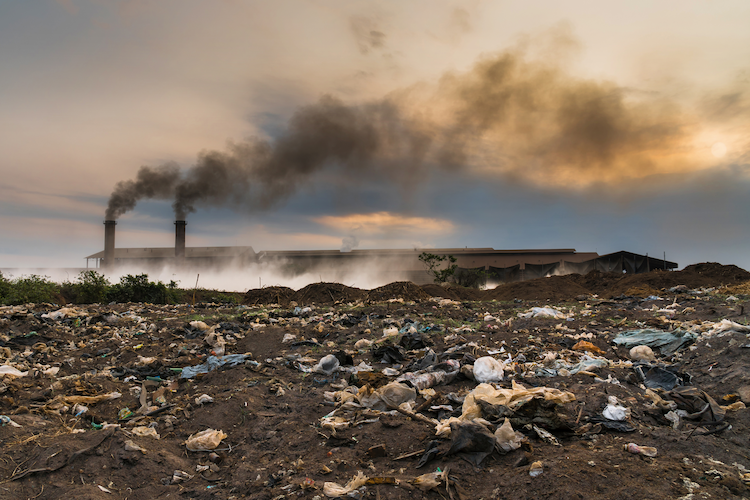Supreme Court Hears Challenge to EPA’s Good Neighbor Rule

The U.S. Supreme Court heard oral arguments in four cases last week. One of the most closely watched is Ohio v. Environmental Protection Agency, which challenges the U.S. Environmental Protection Agency’s (EPA) “Good Neighbor” pollution rule.
While the case centers on the EPA’s regulation of interstate air pollution under the Clean Air Act, the issues before the Court are largely procedural. The Clean Air Act tasks the EPA with establishing National Ambient Air Quality Standards for certain air pollutants, including ozone. States must then devise plans to implement the standards. As relevant to the case, state plans must detail how each State would satisfy the Act’s “good neighbor” provision, which requires “upwind States to reduce emissions to account for pollution exported beyond their borders.” The EPA is authorized to impose a federal plan if a State fails to submit a statutorily compliant plan.
In October 2015, the EPA revised air-quality standards for ozone pollution, National Ambient Air Quality Standard for Ozone, which triggered the States’ obligation to update their state-implementation plans. In 2023, the EPA disapproved the submissions of 21 states and proposed its own federal-implementation plan. Ohio, Indiana, and West Virginiafiled suit, arguing that EPA’s rulemaking process circumvented the Clean Air Act’s cooperative-federalism mandate by forcing its own top-down control over state-level air-pollution reduction, and moved to stay the federal plan pending judicial review. The Fifth Circuit Court of Appeals denied the motions to stay and the States appealed to the Supreme Court.
The States have asked the justices to stay implementation while litigation continues in the lower courts. The specific questions that the Court agreed to answer are: (1) Whether the court should stay the Environmental Protection Agency’s federal emission reductions rule, the Good Neighbor Plan; and (2) whether the emissions controls imposed by the rule are reasonable regardless of the number of states subject to the rule.
While the case is procedural in that it asks the Court to grant a stay, one of the criteria the justices must consider when deciding whether to stay the EPA rule is whether it believes the challengers are likely to prevail in the lower court. Accordingly, the Court’s decision should shed light on how the justices view the merits of the case.
Below is a brief summary of the other cases before the Court:
Bissonnette v. LePage Bakeries Park St., LLC: The Federal Arbitration Act exempts the “contracts of employment of seamen, railroad employees, or any other class of workers engaged in foreign or interstate commerce.” The First and Seventh Circuits have held that this exemption applies to any member of a class of workers that is engaged in foreign or interstate commerce in the same way as seamen and railroad employees — that is, any worker “actively engaged” in the interstate transportation of goods. The issue before the Court is “[w]hether, to be exempt from the Federal Arbitration Act, a class of workers that is actively engaged in interstate transportation must also be employed by a company in the transportation industry.”
Corner Post, Inc. v. Board of Governors of the Federal Reserve System: Petitioner Corner Post, Inc. sued the Board of Governors of the Federal Reserve System under the Administrative Procedure Act (APA), challenging a Board rule adopted in 2011 that governs certain fees for debit-card transactions. The Eighth Circuit Court of Appeals held that Corner Post’s APA claims were barred by 28 U.S.C. §2401 (a)’s six-year statute of limitations, holding that that Corner Post’s APA claims “first accrue[d]” when the Board issued the rule in 2011-even though Corner Post did not open for business until seven years later. The justices have agreed to consider the following question: “Does a plaintiffs APA claim ‘first accrue[]’ under 28 U.S.C. §2401(a) when an agency issues a rule-regardless of whether that rule injures the plaintiff on that date (as the Eighth Circuit and five other circuits have held)-or when the rule first causes a plaintiff to ‘suffer[] legal wrong’ or be ‘adversely affected or aggrieved’ (as the Sixth Circuit has held)?”
Warner Chappell Music, Inc. v. Nealy: The cases is set to resolve a circuit split regarding the statute of limitations in copyright infringement cases. The specific question the justices must decide is “whether the Copyright Act’s statute of limitations for civil actions, 17 U.S.C. 507(b), precludes retrospective relief for acts that occurred more than three years before the filing of a lawsuit.”
Previous Articles
SCOTUS Takes Up Key Election Case Involving Mail-In Ballots
by DONALD SCARINCI on December 17, 2025
The U.S. Supreme Court recently granted certiorari in a key election case, Watson v. Republican Nat...
SCOTUS Adds Second Amendment Case to Docket
by DONALD SCARINCI on November 27, 2025
The U.S. Supreme Court will consider another important Second Amendment case this term. The latest ...
Key Takeaways from Oral Arguments in Court’s Controversial Voting-Rights Case
by DONALD SCARINCI on November 12, 2025
The U.S. Supreme Court recently heard oral arguments in Louisiana v. Callais, which involves a key ...
The Amendments
-
Amendment1
- Establishment ClauseFree Exercise Clause
- Freedom of Speech
- Freedoms of Press
- Freedom of Assembly, and Petitition
-
Amendment2
- The Right to Bear Arms
-
Amendment4
- Unreasonable Searches and Seizures
-
Amendment5
- Due Process
- Eminent Domain
- Rights of Criminal Defendants
Preamble to the Bill of Rights
Congress of the United States begun and held at the City of New-York, on Wednesday the fourth of March, one thousand seven hundred and eighty nine.
THE Conventions of a number of the States, having at the time of their adopting the Constitution, expressed a desire, in order to prevent misconstruction or abuse of its powers, that further declaratory and restrictive clauses should be added: And as extending the ground of public confidence in the Government, will best ensure the beneficent ends of its institution.





